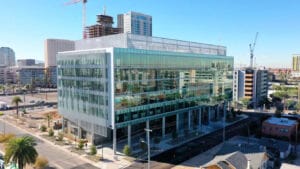In 1960, the ribbon was cut on the Sun City retirement community in the West Valley. The project received considerable fanfare, with builder Del Webb featured on a 1963 cover of Time magazine promising “a new way of life for the old.” In the decades since, the West Valley has grown to be more than a retirement promised land – and away from its agricultural roots.
“Our median age in the West Valley is 35 years old. In the East Valley, it’s 36 years old, and that includes all the ASU students,” says Sintra Hoffman, president and CEO of WESTMARC. “The region had this reputation of being a retirement community, but that is not the case today.”
READ ALSO: Here’s why the West Valley is exploding with economic growth
The West Valley is attracting people and businesses from around the country and world, giving residents more opportunities to live, work and play in their own backyard. As more families choose to raise children in the West Valley, training and retaining young talent is crucial for the region’s sustained success.
Seeking education
From an economic development standpoint, education is a worthy investment. When global and national companies are selecting sites, having an educated workforce in place is a high priority.
“As economic developers, we can do the things companies need to get them here,” remarks Christine Mackay, community and economic development director for the City of Phoenix. “But we can’t fake an educated workforce, whether it’s at the Ph.D. level, mid-manager level or high school graduates coming into entry-level jobs.”
Mackay believes that education is often forgotten in the pursuit to attract companies. “As economic developers, we often overlook that connection for families on education and future workforce opportunities when we bring in these global and national companies,” she explains. “Deer Valley Unified School District serves the area where the Taiwan Semiconductor Manufacturing Company (TSMC) is moving. The parents who are coming in from Taiwan, Europe and other parts of the country want to know what kind of education their children will get.”
Starting early
Future growth and today’s education practices are linked. Strong partnerships between education and industry mean that students are equipped for good jobs, and companies have the necessary workers to operate.
“We partner with West-MEC on our projects and worked with our semiconductor companies to create entry-level fabrication technician roles that don’t need a seven-year degree. They can take a high school graduate who has gone through these career training programs and get an incredible job,” says Mackay.
Jessica Putton is the director of career services at West-MEC, a career and technical education high school district that serves the West Valley. The district is heavily involved with economic development groups like WESTMARC and the chambers of commerce throughout the West Valley.
“We try to be part of the conversation so everyone can get to know West-MEC and see that we can connect businesses and industry partners with our students at every opportunity,” comments Putton. This leads to partnerships with companies such as Avanti Windows & Door and organizations like the Arizona Masonry Council. “Multiple industry partners have taught sections of our curriculum to students,” recalls Putton.
These interactions create a talent pipeline for industry partners and expose students to opportunities available to them. Most students, Putton says, want to stay in the West Valley if they’re entering the workforce after high school – and many graduates find jobs leveraging their established industry connections.
Putting down roots
The Arizona State University (ASU) West campus opened in 1984, and its expansion mirrors the rest of the West Valley. “Our student enrollment at the West campus grew by 25 percent last year,” says Bobbi Magdaleno, executive director of government and community engagement for ASU. As enrollment at ASU West has flourished, so have the number of programs. “We have approximately 120 degrees available just at the West Campus.”
The West Valley has many options for training young folks, but retaining them as they graduate high school or college takes concerted effort. That’s why, in 2019, WESTMARC partnered with the Center for the Future of Arizona to get involved in their efforts around young talent.
“We engaged with the Center for the Future of Arizona and pulled together young representatives from the West Valley to make sure they had a seat at the table. We want them to know that they are heard, valued and embedded in the work that’s happening in the region,” says Kimberly Jordan, director of strategic partnerships and business development for WESTMARC. Based off the 13 priorities identified through these conversations, WESTMARC is launching a young talent spotlight program which will culminate in a new award category at the annual Best of the West Awards Dinner.
Leadership West – while not tailored exclusively to young people – is a leadership development program focused on teaching participants about the West Valley and how to show leadership in the region. Katie Mehin, collaboration success manager at Brighthive, was part of Leadership West’s 21st cohort.
“You get to hear from speakers around the West Valley about different issues and engross yourself in information around topics like job creation, infrastructure and education,” comments Mehin. The program also includes facility tours, leadership training and a retreat.
This broad exposure to people and ideas, Mehin claims, leads to a deeper connection to the West Valley. “I participated in 2015, and I learned so much from the people in my class, whether they had 30 years of service on a board or if they were a young professional like me. I’m still connected with all the people who were in my class. And even if someone wasn’t in my class, I know that I could reach out and say, ‘Hey, I was in Leadership West’ and have this immediate connection.”
Adds Magdaleno, “I’m impressed with Leadership West because it engages participants in a way that creates a burning desire to stay in their communities and make a difference.”



